The Symphony Gramophone and Radio
Company Limited
| In the summer of 1928, radio production at A.J.S.
ended, and the Stewart Street factory was put up for sale. It was purchased by a new business venture, the Symphony Gramophone and
Radio Company Limited, registered on 5th October, 1928, with a
registered office at 1 Cornhill, London. The factory was acquired for
£15,375, and taken
over on 30th October. When the Symphony Gramophone and Radio Company
Limited was formed, a successful share issue raised £200,000, which was
used to buy and set-up the Stewart Street factory, and another factory
in Abergavenny, purchased from the Gilwern Manufacturing Company.
Gramophones, radios, and loudspeakers were built in Wolverhampton, and
gramophone motors were made at Abergavenny. |
|
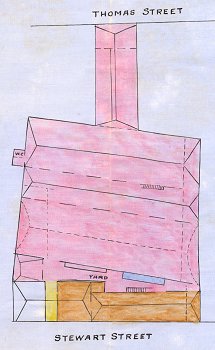
A plan of the works. |
The new company not only purchased the Stewart Street
factory, but also
the contents, including the machinery and radio components.
About 100 people were employed in the works, presumably most of
them were ex-A.J.S. employees. Symphony's product range
included a battery-powered radiogram, with a wind-up turntable,
a transportable receiver, a five-valve portable receiver, a
deluxe mains-powered radiogram and high quality loudspeakers in
cabinets.
All of the cabinets and loudspeakers were made in-house. The
bought-in Plessey circuit board used an advanced technique, a little
like a modern printed circuit board, for connecting the electronic components. Brass pressings were riveted onto a sheet of
bakelite and special hollow rivets were used instead of valve holders.
Some
of the components such as switches, knobs, and valves appear to be
obsolete A.J.S. stock.
|
| Another advanced technique involved a special finish that
was given to the cabinets on some of the models. The cabinets
appeared to be veneered in burr-walnut, but in fact it was plain
wood.
The realistic walnut finish involved a secret photographic
process, possibly originally developed by A.J.S. It was used on
some A.J.S. metal horn loudspeakers.
Only photographic staff
were allowed into the photographic area, which was out of bounds
for everyone else. |
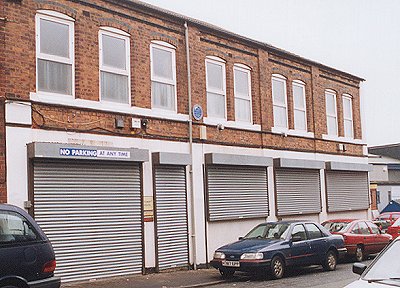
The factory, as it is today. |
| The company also used elliptical loudspeakers, which give a
good all-round frequency response. Symphony must have been one
of the first manufacturers, if not actually the first to produce
elliptical cones. Mel Price ran the company and later worked
in Lichfield Street Co-op. The radiograms and radios were
designed by a gentleman who lived at Cannock, using a standard
circuit board that was purchased from Plessey.
Loudspeakers were produced in a building at the back of the
yard, known as "the boat house", because a ramp led up to the
entrance. About 50 young girls were employed on the assembly of
reed-type, and moving coil units. The loudspeakers were produced
for inclusion in the radiograms and radios, and also as stand
alone units. The cases were assembled in the cabinet making
department.
Background to the Circuit Board
The Plessey Company Limited was formed in
December 1917, with a nominal capital of £3,000, including
£1,000 made up of shares issued by subscription. The
shareholders were Bill Heyme, Hurst-Hodgson and two brothers,
Raymond and Plessey Parker. Plessey started life making jigs and
tools in an old musical instrument factory. Soon after the
company’s formation, Hurst-Hodgson and the Parker brothers were
bought out. The directors were then Bill Heyme and Mr. Davieson.
In 1921, American B. G. Clark gave Plessey
an order for tools to make tags and eyelets for his shoe
business. He was extremely impressed with Plessey, and
immediately acquired a large number of shares in the company, in
the name of his son Allen, as a way of launching him into a new
career. In September 1921 Allen became Company Secretary, to
form a partnership with Managing Director Bill Heyme.
Early in 1922, just before the formation of
the BBC, Marconi began to look for manufacturers to produce
Marconi receivers under contract. B. G. Clark heard about this,
and quickly realised the potential for domestic radio receiver
production. Along with his son Allen, and a mutual friend, he
formed the British Radio Phone Company to tender for radio
orders, which would be sub-contracted to Plessey. The company
soon received an order from Marconi for 500 'Junior' Crystal
sets, 5,000 'A' crystal sets, and 5,000 'V2' receivers. As a
result Plessey moved to a larger factory in 1923. Around the
same time, Marconi founded a subsidiary company, Marconiphone to
handle the distribution of its receivers.
By 1924, 80% of Plessey's turnover came
from work for Marconiphone, and so Plessey had to agree when
Marconiphone decided to buy shares in the company, and nominate
two directors. The following year saw the formation of Plessey
(1925) Limited.
In 1926 Marconiphone acquired its own
manufacturing company, Sterling Telephone and Electric, at
Dagenham. As a result it sold its Plessey shares, and its two
nominees left the board. The contracts with Plessey soon ended,
and so Plessey had to quickly find alternative orders. As a
stop-gap, Plessey designed the 'National' five valve portable
receiver, which would be sold as a kit to the Symphony
Gramophone and Radio Company, and the Columbia Graphophone
Company.
Marconi also produced an almost identical
receiver, the Marconiphone '55' using Plessey components and a
similar circuit board.
The Products
Battery-Powered Radiogram |
|
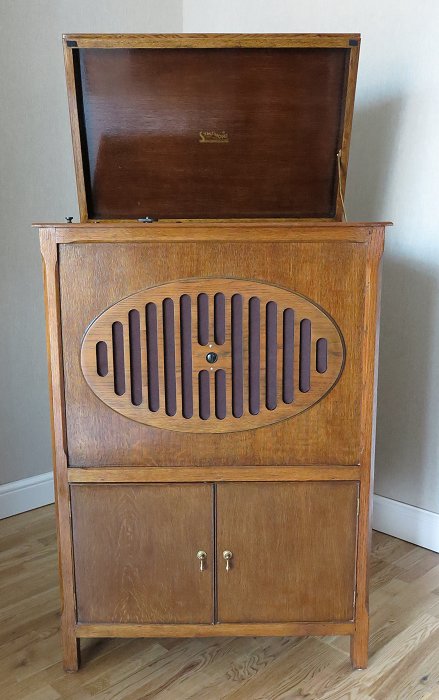
The Symphony battery-
powered radiogram. |
The battery powered radiogram uses a Plessey circuit board, with the components mounted onto a bakelite board and
connected by shaped brass pieces, which are riveted in place.
This may
well have been the first type of modern circuit board used in this
country. The only other manufacturer I have so far found who adopted
this technique was Blaupunkt in Germany.
It has a large internal frame aerial, which fills half of the cabinet,
and can be rotated by a large knob on the front panel. The aerial has
two coils, one for Long Wave and one for Medium Wave, with the aerial
rotating knob acting as the wavechange switch. For half of its
rotation the radio is switched to Long Wave, and for the other half it
is switched to Medium Wave.
The receiver is very sensitive and performs
extremely well for a T.R.F. design from the 1920s. The radiogram has a
large elliptical reed-type loudspeaker and sounds very good indeed. It
has an oak cabinet, uses a B.T.H. tone arm and pickup head, and a
wind-up Collaro turntable. |
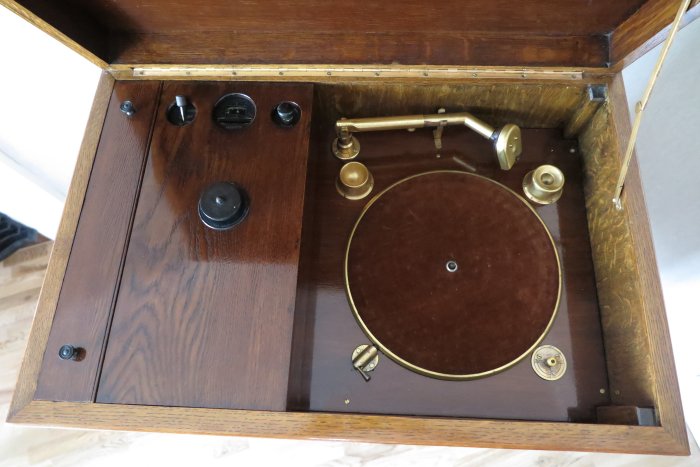
The top view of the radiogram. The
panel on the left covers the valves, the large knob in the
centre rotates the internal frame aerial and also acts as a
wavechange switch. The pick-up and tone arm are made by
B.T.H. and the wind-up turntable is a Collaro type A28. |
|
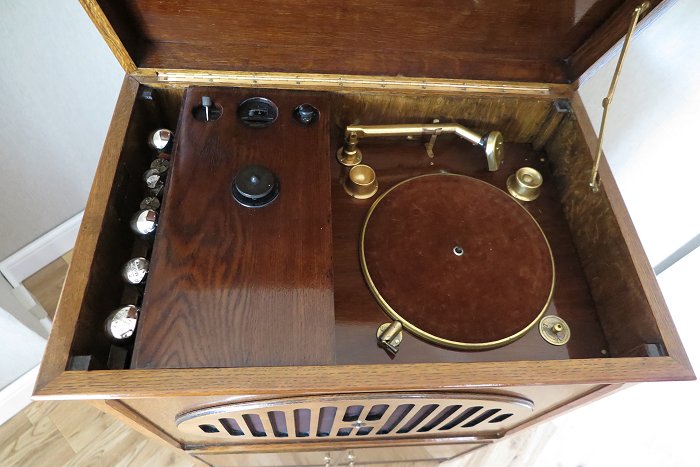
Another view of the top, with the
valve cover removed. |
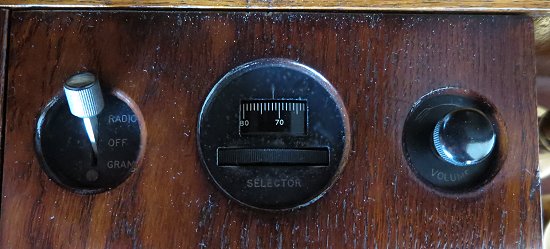 |
A close-up view of the controls. |
 |
The
underside of the circuit board showing the brass strips and
rivets. |
| The circuit board showing
the compact form of construction, for the time. |
 |
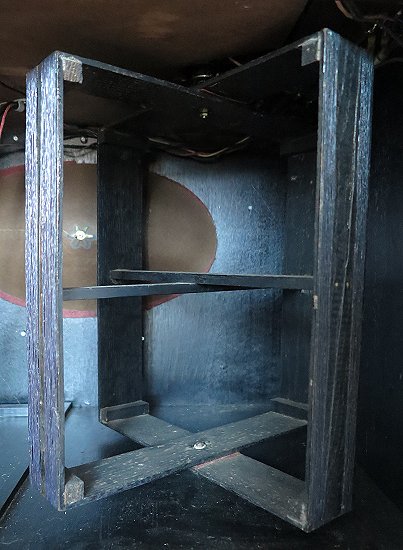 |
The frame aerial with the loudspeaker
behind. |

The circuit diagram of the battery powered
radiogram.
| V1 |
T.R.F. receiver with a balanced frame aerial. |
| V2 |
Radio frequency amplifier. |
| V3 |
Detector and first audio amplifier for the radio. |
| V4 |
Audio pre-amplifier. |
| V5 |
Audio output stage.
|
The radiogram was available in oak, mahogany, or burr
walnut, and could also be purchased without the lower record
storage cabinet. Prices were as follows:
| Oak |
35 guineas |
| Mahogany |
37 guineas |
| Burr Walnut |
48 guineas |
| Without the record cabinet |
From 32 guineas |
|
|
|
|
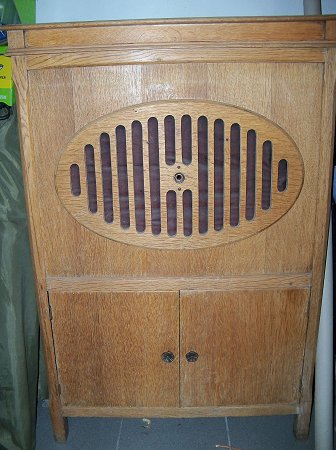 |
|
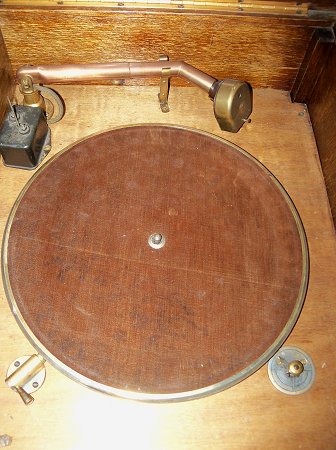 |
|
Two
photographs of a Symphony radiogram that is in
Belgium. Kindly sent in by Marijke Moysons. |
|
|
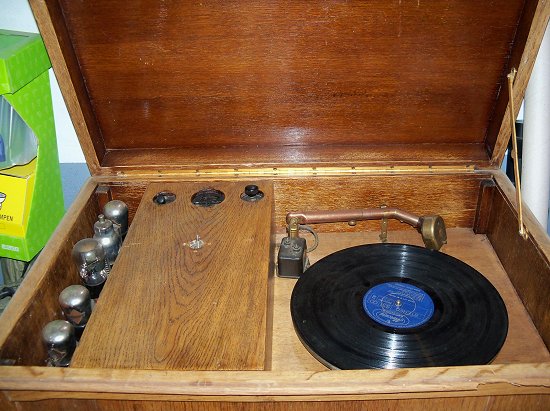
Another photograph of Marijke Moysons'
Symphony radiogram. |
|

The view inside Marijke Moysons'
Symphony radiogram. |
|
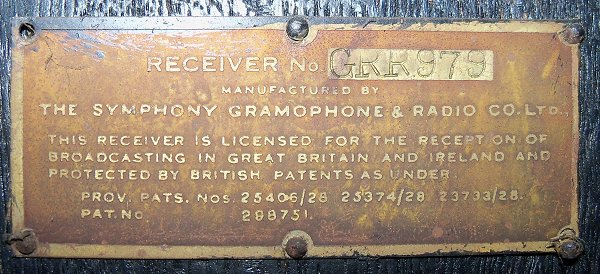
The manufacturers' plate on the inside
of Marijke Moysons' Symphony radiogram. |
|
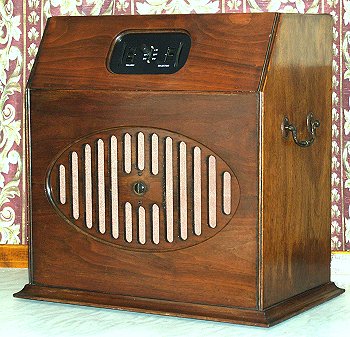
The Symphony Transportable Receiver. |
The Transportable Receiver
This receiver uses an almost identical circuit board to the
battery-powered radiogram and performs equally well.
Unlike the
radiogram it has two separate frame aerials and a turntable on the
bottom, so that the case can be freely rotated to obtain the strongest
signal. The receivers were solidly built and produced in large numbers
The two handles are identical to those used on A.J.S. Type 'F'
pedestal models and so were presumably made in-house. |
|
The receiver has two wavebands, Long Wave and Short Wave.
The short waveband doesn't cover what we think of as short
wave today, it actually covers about two thirds of the
medium waveband. The moving-iron loudspeaker uses an
A.J.S. patented mechanism that was originally used in the
A.J.S. 'Symphony' portable receiver. |
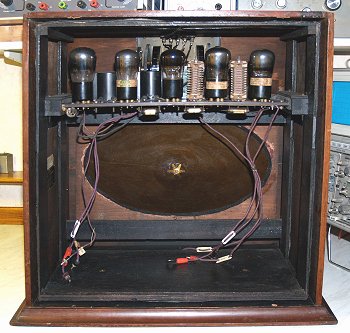
The inside of the receiver. |

The circuit diagram of the Transportable Receiver.
| V1 |
T.R.F. receiver with a balanced frame aerial. |
| V2 |
Radio frequency amplifier. |
| V3 |
Detector and first audio amplifier. |
| V4 |
Second audio amplifier. |
| V5 |
Audio output stage.
|
| The two photographs above show the tuning capacitor,
which was made in-house. The design is almost identical to
the later A.J.S. types, except that brass is used for the
plates instead of aluminium. |
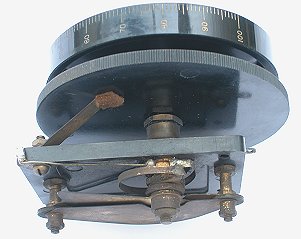 |
The reaction capacitor and
adjusting knob. On the control panel it is called "volume". |
| The loudspeaker mechanism with the
cone removed. The mechanism is identical
to what was used in the A.J.S. Symphony portable receiver,
and is an A.J.S. design.
The elliptical cone is made from
varnished card, and uses a strip of felt for the suspension.
The loudspeaker performs extremely
well for such a simple design and is presumably helped by
the rigid and lightweight elliptical construction. |
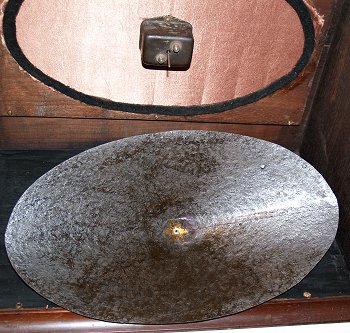 |
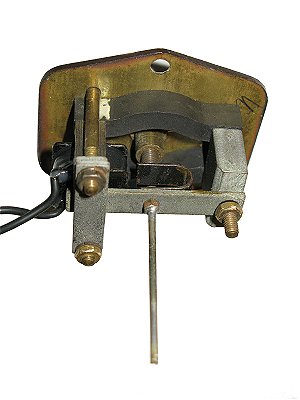 |
|
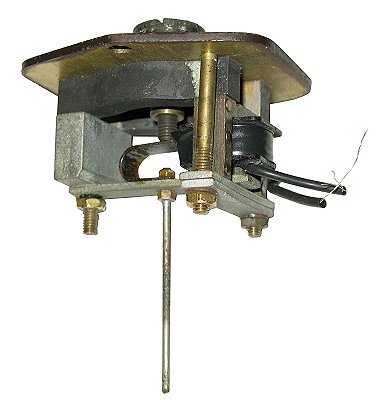 |
| Two views of the
simple A.J.S. patented moving-iron loudspeaker mechanism
used by the Symphony.Gramophone and Radio Company. It
.consists of an iron reed, mounted between the pole pieces
of a magnet, one end being fixed, the other allowed to move
between an end-stop, and one of the pole pieces. At this end
is the coil which varies the magnetic field. The screw on
the front positions the reed via a return spring.
|
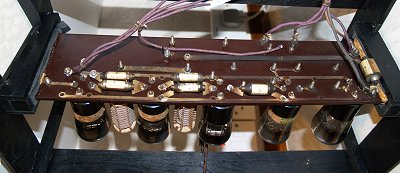 |
The underside of the circuit board
showing the shaped brass strips. At first glance it looks
very similar to a modern printed circuit board. |
| A view of the top of the circuit
board, which is very similar to the one used in the
radiogram. |
 |
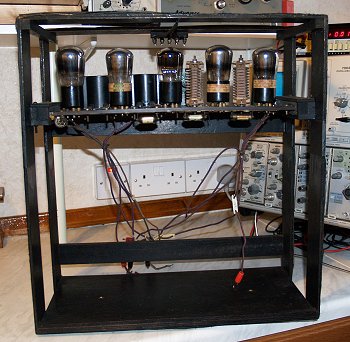 |
The receiver removed from the
case. The two frame aerials
can be clearly seen around the outside of the wooden frame.
The one at the front is for Short Wave and the Long Wave
coil is at the rear. |
| A close-up view of the
circuit board. |
|
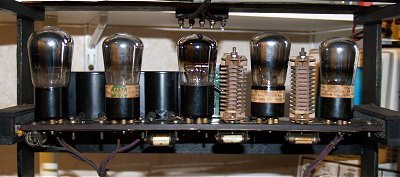 |
 |
The serial number is 285, which
suggests that it was made fairly early on. |
| A final view of the
transportable receiver showing its handsome appearance. |
|
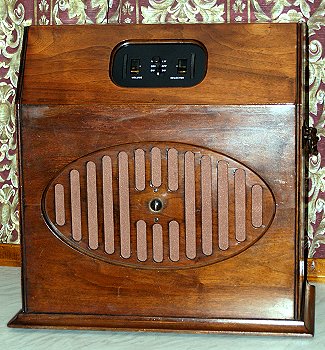 |
|

A Symphony portable receiver. Courtesy
of |
The Battery Portable Receiver.
The Symphony portable receivers were built by three men who
worked on the ground floor of the main Stewart Street
building, just to the right of the entrance.
The receiver used the standard type of Plessey circuit
board and had two frame aerials, one for Medium Wave inside
the front of the case, and one for Long Wave in the opening
back. It used the company's standard elliptical loudspeaker
and sold for £17.17s.6d. |
|
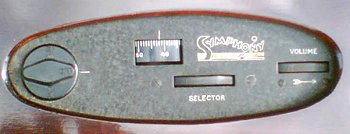
The control panel. Courtesy of Colin
Fisher. |

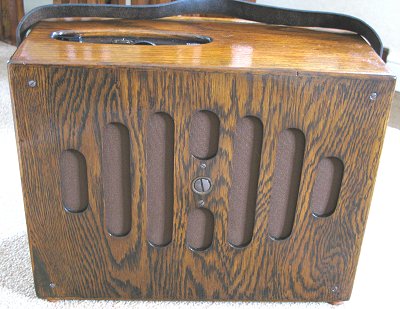
|
A
'National' portable receiver. |
|
Symphony also made a version of the portable receiver,
carrying the 'National' name. They are identical to Symphony's own portable, as seen
above, except for the case. |
| An inside view of the National receiver
showing the light-weight construction. |
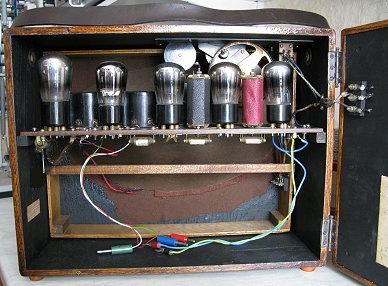 |
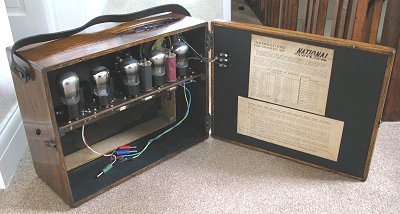 |
Another view of the same receiver. |
|
The control panel on the National
receiver. |
 |
 |
The underside of the circuit board. |
| A top view of the circuit board. |
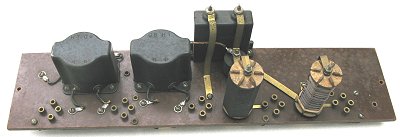 |
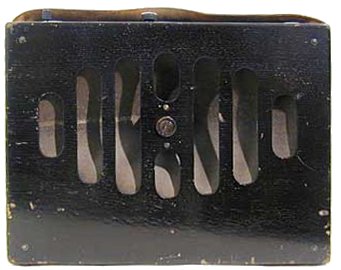
A National portable receiver. Courtesy of
Steve Harris of On the Air Limited. |
What is possibly an earlier version of the National receiver.
The controls are not as refined as in the later version. |
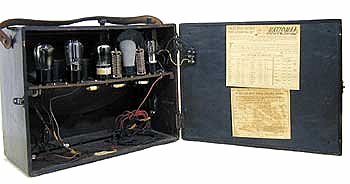
|
A view of the inside of the earlier
National portable. Courtesy of Steve Harris of
On the Air Limited. |
|
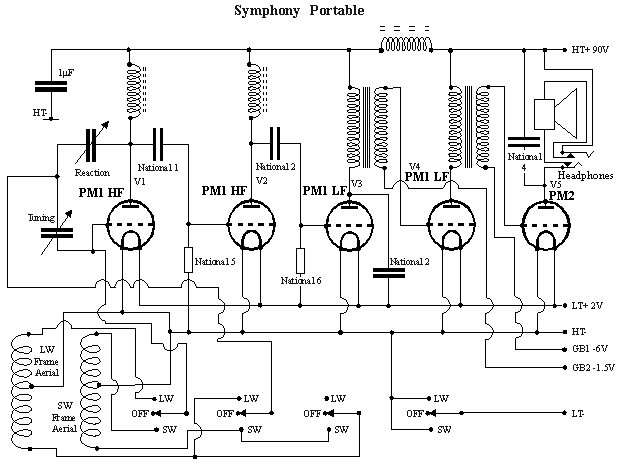
The circuit diagram of the portable receiver.
|
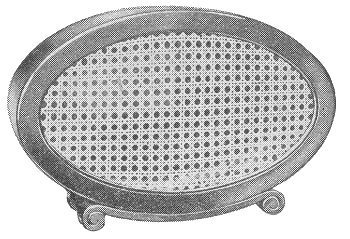
The Symphony "Oval" loudspeaker. |
The company had a stand at the Radio Show at Olympia in
September, 1929. On display were the "Oval" loudspeaker and two types of
radiogram; the battery powered model and the Symphony "De luxe".
The elliptical loudspeaker was mounted in a novel,
oval-shaped wooden cabinet with a woven cane grill. The loudspeaker had
a reed-type movement that drove a cone diaphragm and sold for £3.10s.0d.
|
| The Symphony "De luxe" radiogram was housed in a
high quality cabinet and mains powered.
The
turntable was driven by an electric motor, and in
the cabinet was a large moving coil loudspeaker with
a special form of suspension.
Unlike the battery powered radiogram, the "De luxe" model
featured an all metal chassis.
Indirectly heated valves were
used and the audio amplifier was powerful enough to provide
dance music for a small hall.
The radio had an internal frame
aerial and featured a screen grid R.F. amplifier for high
sensitivity.
It sold for £125.
|

The Symphony "De luxe" radiogram. |
Very high quality, one-off radiograms, with large audio
push-pull output stages were also produced. Each one costing
several hundred pounds. Some of the radiograms featured the
burr-walnut finish, which was produced using the special
photographic technique.
|
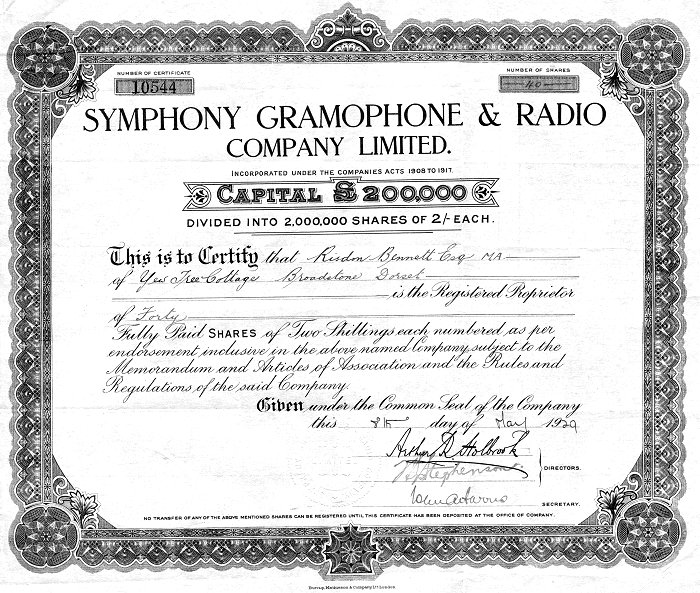
A share certificate.
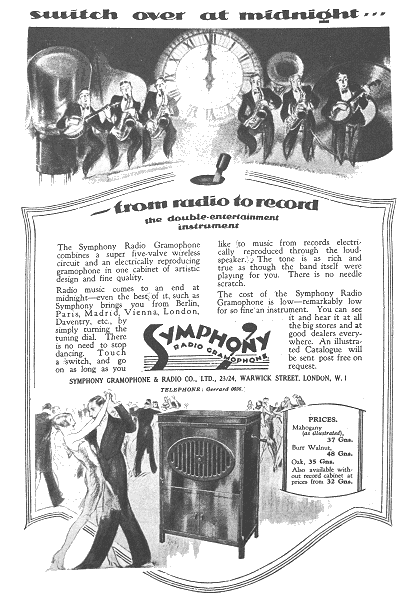
An advert from the Illustrated London News, 27th
April, 1929.

From the Illustrated
London News, 14th December, 1929. |
|
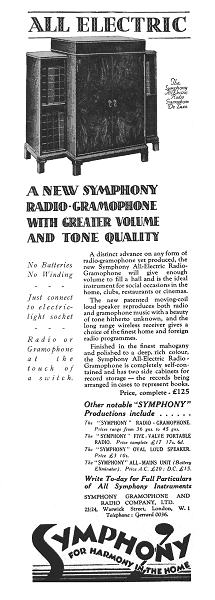
From the Illustrated London News, 5th
October, 1929. |
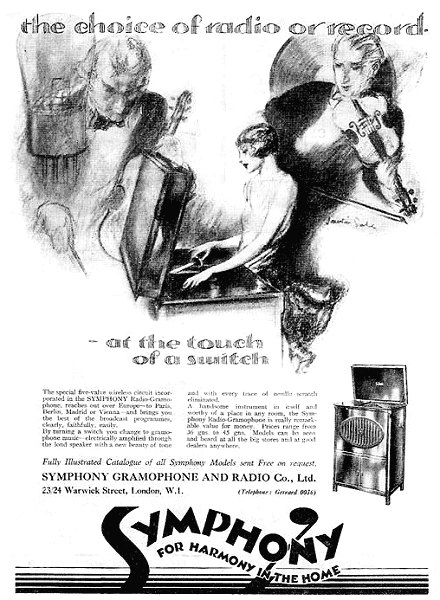
Another advert from October 1929.
| Symphony also produced the Symphony All-Mains Unit, a
mains-powered battery eliminator. The AC version sold for
£20 and the DC version sold for £15. |
| A Sad End Unfortunately the company was not successful. The
battery-powered radiogram appears to have sold in large numbers,
but suffered from a serious problem. The bakelite sheet onto
which the components were mounted was very thin, and would
frequently warp and bend, under the weight of the components.
The added stress that this placed on the thin brass rivets,
which secured the brass connecting strips, would often lead to
failure. The rivets would either break or stretch, leading to a
poor connection. If a thicker piece of bakelite had been used,
or if the board had been better supported, this would not have
happened. Hundreds of the radiograms were returned, which eventually led to the company's demise.
The Symphony Gramophone and Radio Company Limited went into
liquidation on 17th March, 1930. Henry Morgan of 54 New Broad
Street, London was appointed as liquidator. The company had
clearly been in financial difficulties for some time.
On January 2nd, 1930 the Plessey Company Limited of Vicarage
Lane, Ilford, Symphony's main creditor, handed a petition to
the Chancery Division of the Companies Court in an attempt to
obtain money that was owing to it. The petition was also
signed by the Igranic Electric Company Limited, Saxton
Chatterton & Company Limited, James Relle Morris, D. M. Davies
(Woodwork) Limited, and 123 of Symphony's other creditors.
The Court ordered that the Symphony Gramophone and Radio
Company Limited should be wound up under the provisions of the
Companies Act of 1929.
The company's assets were duly sold including the factory,
which was purchased by Birmingham estate agents Thomas Foden
Flint and Alfred Edward Jones. It sold for £1,175.
Apart from the problem with the circuit board, the
radiograms worked extremely well. At least one working model still
survives, and is extremely sensitive for a T.R.F. receiver of that
period. The company produced high quality products, which when working,
could compete favourably with anything else on the market at the time.
If a thicker piece of bakelite had been used for the circuit board in
the battery-powered radiograms, it could all have ended very
differently.

|
I would like to thank ex-Symphony employee, the late Charles
Weight, for his help in producing this brief company history.
If anyone has any information about the company, or
knows of any surviving products,
please email me. I will be delighted to hear from you.
|

|
| Return to
the Engineering Hall |
|